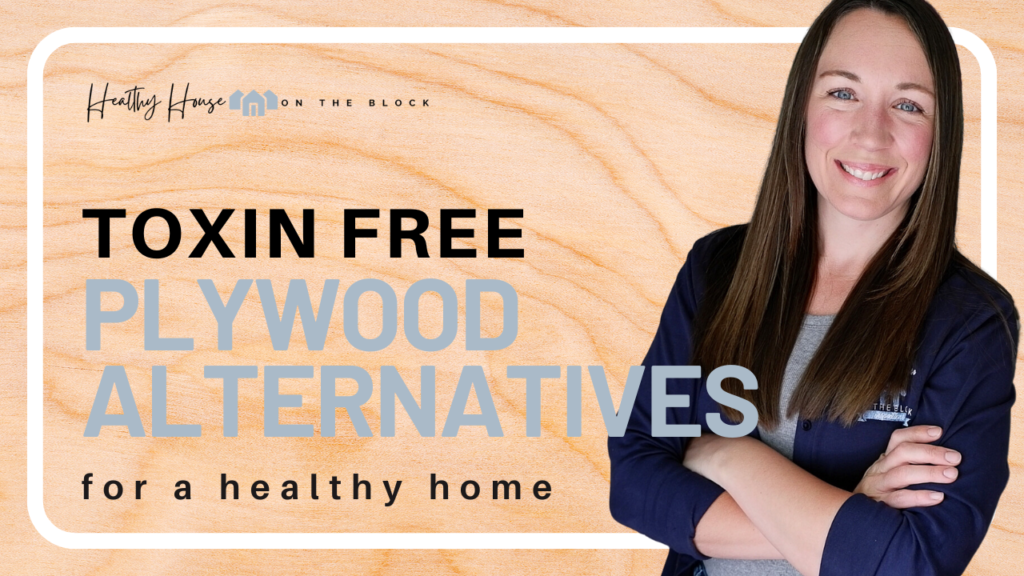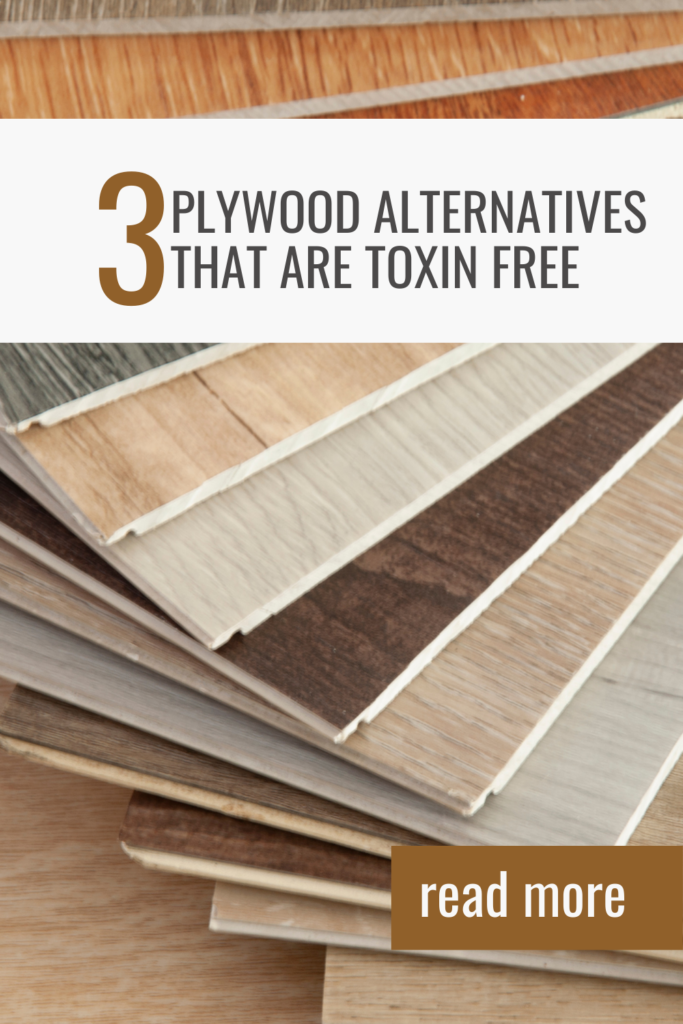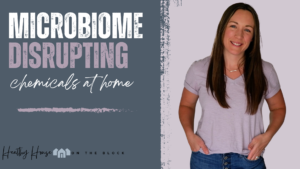
Plywood is a really common and widely used material when it comes to our home’s materials and furniture. But lately you may have seen a few “plywood alternatives” and wondered what that is all about. Afterall, isn’t plywood just parts of wood? Well yes, and no. Plywood is definitely made up of wood, but unfortunately it also contains various types of solvents that make it an unhealthy option for your home.
This is where those plywood alternatives come in. These new alternative materials not only cut out solvents, but use products that are healthier for our spaces. The biggest concern with the solvents in plywood is that they off gas FOREVER. The solvents and VOCs that are present in the plywood gets off-gassed into the air in your home for as long as that plywood is there.
I think the largest factor that comes into play when talking about the toxins that are expelled from plywood is that oftentimes in our homes there is just SO much plywood. If you have a two story home or a home with a basement that has been built later than the 1960s, you likely have a whole subfloor system made of plywood. The same is true for any attic spaces and roof sheathing. This means that there is a really large quantity of plywood in your home that is all off-gassing at the same time.
I didn’t even get into the plywood that is often found in most furniture (even if part of the furniture is solid wood) and cabinets. So you can see that plywood is used in so many applications, that it has become a concern to our health and wellness.
The good news is there are ways to deal with plywood that you currently have at home without replacing it with plywood alternatives. And if you’re looking to tackle a new project, you can find plenty of other options besides plywood to prevent bringing toxins inside
WHAT IS PLYWOOD MADE OF?
Plywood is man made and engineered in factories. Plywood often is made up of very thin sheets of peeled wood that has been debarked. These thin veneer sheets are then adhered together with a strong adhesive glue.
Once the wood sheets are bound together with the adhesive, it forms a composite like material, making it a stronger option than things like particle board and chipboard,which are in the same family as this engineered wood.
The panels are glued together with the grains of each board running opposite and perpendicular so that it creates a strong panel. They are also usually glued together with an odd number of veneers so that there is less warping in this type of board.
There are also different grades of plywood which has mostly to do with the knots in the natural wood being used. And you can also get plywood in different types of woods, which are mostly categorized in softwoods and hardwoods.
The wood itself poses very little in terms of health concerns when it comes to plywood. The real culprit of plywood is in the adhesive itself. The adhesives that are used to glue the veneers together are often made of Urea formaldehyde glues, polyvinyl acetate, melamine formaldehyde glues, and phenol glues.

TOXINS PRESENT IN PLYWOOD
Looking at those glues and adhesives being used I’m sure you recognized a few toxins that were present.
First, formaldehyde is present in most of the gle options for plywood. Formaldehyde has been shown to have a number of health risks, including an increased risk of cancer. This study discusses how our household concentrations of formaldehyde are contributing to skin sensitization, eye and respiratory irritation as well as an increased risk for cancer.
Another study linked formaldehyde to headaches, dizziness and an inability to concentrate as well as sleep disturbances.
Another toxin in plywoods is polyvinyl acetate, which has been listed as a hazardous substance. It’s an extremely flammable liquid and is not soluble in water, which is why it makes such a great adhesive. However, the chemical toxin contributes to both long term and short term toxicity in humans. This study showed that it was carcinogenic in some instances and caused liver disturbances in other instances.
The glues that contain phenol resin also contain formaldehyde in the adhesive that plywood is manufactured with. This study that is specifically about plywood and the phenol-formaldehyde resin glue used in the product shows that this VOC contributes to irritation of the skin and airways.
A relatively large study shares the characteristics of formaldehyde has a toxin in our indoor environment, stating that formaldehyde is quickly absorbed into our bodies through our skin and airways. This same study references the fact that the International Agency for Research on Cancer has classified formaldehyde as carcinogenic to humans due to home exposures.

HEALTHY PLYWOOD ALTERNATIVES
So now that we know all the health effects linked to formaldehyde and we KNOW that there is plenty of it in our homes, you might be wondering if there are some safe and healthy plywood alternatives that can be used in furniture, projects and home building.
Thankfully, there are some really great plywood alternatives that will limit the introduction of toxins in your home.
SoyStrong Maple Plywood: This plywood is carried at Lowe’s and is made with a soy based glue rather than a formaldehyde glue. This is really great as plywood alternatives and it is similar in structure and performance to other plywoods but is harvested from sustainable resources and contains no added formaldehyde to the boards.
PureBond Birch Plywood: Purebond can be found right at Home Depot stores, which makes it a PERFECT alternative for a project you’re looking to complete or a home improvement you’re going to tackle. They have replaced the formaldehyde with a soy-based adhesive which is similar in performance, but contains none of the chemicals present in typical adhesives.
The other positive benefit to using PureBond as boards as plywood alternatives is that it is extremely close in cost to regular plywood, making it easy to stay within your budget.
Structural Cementitious Sheathing Board: This is a great option but cannot necessarily be used in all applications. It is best used in new construction and must have the proper structural support behind it. These boards are made of non-combustible concrete and offer a great fireproof alternative to plywood.
IF PLYWOOD ALTERNATIVES AREN’T AN OPTION FOR YOU
And maybe you’re in the boat most of us are in and you’re not really in a position to remove plywood from your home or furniture and therefore plywood alternatives won’t be an option for you.
Don’t be discouraged if you aren’t able to use any of the plywood alternatives mentioned above, because there is a REALLY great option that will work. AFM Safe Seal Plywood Sealer is an excellent option to seal in formaldehyde on plywood, particle board, and other pressed woods. It also adds water and moisture protection to a variety to surfaces it is applied to, which blocks odors that may arise from moisture intrusion.
You can purchase this sealer at The Green Design Center and is simply painted on with a roller or brush to plywood surfaces. It is clear upon drying and odorless when dried as well.
More of my home improvement and product recommendations can be found here.

Share this:
- Click to share on Facebook (Opens in new window) Facebook
- Click to share on LinkedIn (Opens in new window) LinkedIn
- Click to share on Reddit (Opens in new window) Reddit
- Click to share on Pinterest (Opens in new window) Pinterest
- Click to print (Opens in new window) Print
- Click to share on X (Opens in new window) X





Pingback: Healthy Closet Organizers and Minimalist Closet Ideas »
Pingback: Is Plywood Pressure Treated? – Bescord
great post . thankyou you for sharing useful information. we are also a provider of alternate ply